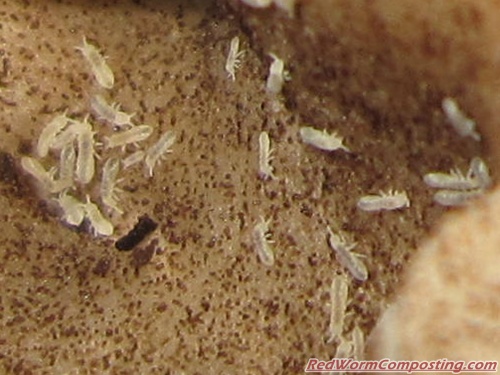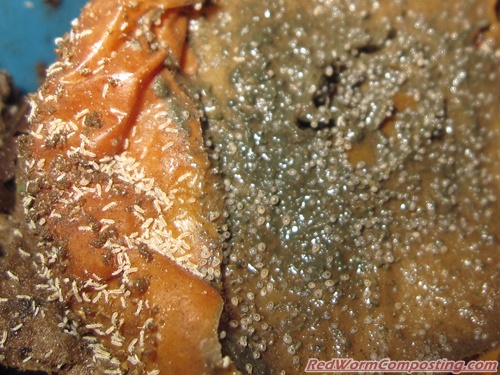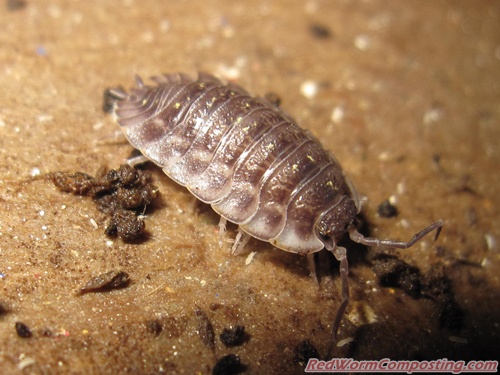April 2011
Wooden Worm Box in Texas Heat
Hi! Thanks so much for such an informative site and my apologies if my
query has been posed before. I have an old wine crate with a sliding
lid and have decided to use it for a 1/4# of worms. I just laid
bedding (shredded newspaper, cardboard and some leaves) and some
vegetable waste into it in anticipation of my worms’ arrival in about
2 weeks. My concern is: I live in Texas where it gets (obviously) very
hot in the summer. I plan to keep my worms outside in an area that is
shaded all the time, but it is still going to be SO HOT, even in the
shade, for the next several months. Will my worms be okay?Thanks again for your time!
Sarah
Hi Sarah,
Interesting question! Let me start by saying that you would definitely have at least one good thing going for you, based on the system you’ve described. When vermicomposting outdoors during hot weather it’s a really good idea to use something at least semi-breathable. A plastic bin outdoors in Texas heat would be a death sentence for most worms I suspect.
Wooden bins are great because they allow for moisture release, which results in an evaporative cooling effect. The trade-off, however, is that you can end up losing a lot of moisture quite quickly. This brings us to the potential downside of your approach. I’m not 100% sure of the dimensions of this box of yours, but when I think of “wine crate” I picture something relatively small. I have a sneaking suspicion you may have a heck of a time trying to keep everything moist inside – even with it sitting in the shade.
Something that might help is partial burial in the ground (may help you keep things cooler as well). Perhaps having a rotation of frozen water bottles (with small perforations for slow moisture release) would be another way to make this work. One last suggestion would be to line the inside of the box with corrugated cardboard or some other breathable material so as to at least provide an extra layer of protection (while still allowing moisture release)
Bottom-line – I definitely think it may be do-able, Sarah, but you may have your work cut out for you!
By the way, you may also want to check this other “Reader Questions” post related to vermicomposting in hot/arid regions:
Vermicomposting in Arid Regions
Hope this helps!
8)
BOM-6000 Bin-04-13-11
Hey gang! I decided to check on the (neglected) BOM bin down in my basement this morning! Always fun to leave bins alone for awhile to see what happens (yeah OK, maybe it’s not always something I do on purpose! haha).
As some you may recall, this is the bin I put the contents of my coffee grounds experiment bin into. Unlike the wooden stacking (experimental) bin, the BOM actually seems to be a good choice for coffee grounds vermicomposting – and I’m sure the same can be said for most enclosed plastic bins. Moisture-retention seems to be very important in terms of making grounds more worm-friendly.
One fascinating discovery this morning was some sort of crazy fungus growing in the bin! Nothing like neglect combined with lots of carbon-rich bedding to get those fungal fruiting bodies growing!
As per usual, I found loads of springtails in the bin as well. They really seem to enjoy a moist (but not sopping wet) environment with good air flow – and I think this system fits the bill quite nicely!
I was actually quite surprised to find some sow bugs (isopods) as well! They never seem to thrive in my enclosed plastic worm bins, but I guess the same conditions that appeal to the springtails appeal to them as well.
I had a heck of a time trying to snap a good shot of one of these guys, but did manage to finally get a decent one! Its large size (by vermicomposting critter standards – it’s like a giant dinosaur in comparison to the small springtails nearby!!) and the macro setting on my point-and-shoot seemed to help!
As for worms – while I didn’t get any nice shots of them, I can assure you that they are doing very well! They are thriving in the bedding-rich environment and, as always, don’t seem to mind my neglect one bit!
Oh, and I should also mention that there is no evidence of coffee grounds in the bin – unless you consider the beautiful, black vermicompost found throughout!
8)
Worm Video Clips
I’m sure by now that most of you are familiar with my good friend, Jerry “The Worm Dude” Gach (current owner of the Worm Inn brand). Most recently he was of course involved in our “Name that Worm Inn” contest (will likely have an update on the “Worm Inn Mega” front for you a bit later in the week by the way).
Well, over the last couple of months or so I have actually been helping him put together a brand new website called…drumroll please…Worm Video Clips (WVC)! As the name implies, the site is devoted entirely to online worm-related videos. The good news for us “Worm-heads” is that a high percentage of the videos are focused on various aspects of vermicomposting.
The primary source of these videos is currently YouTube (so some of them will likely be familiar), but Jerry plans to add videos from a wide range of sources over time – he will even be accepting video submissions! Speaking of which, if you are among those who are still really keen to win a Worm Inn, the good news is that you’ll likely have plenty more opportunities to do so via WVC.
Call me biased (wink wink), but I think Jerry is really onto something with this idea! There’s no doubt that there are plenty of really interesting worm videos posted online – but trying to track them down can be the annoying part. Being able to find a lot of them all in one place is going to be pretty cool if you ask me!
Jerry is definitely eager to get lots of participation on WVC – so if you know of some cool videos, or you have some unique vids you want to submit, be sure to head on over and let him know. The more we all contribute, the better the resource will be!
Looking forward to seeing where this one goes!
8)
P.S. If you are a Facebook user please be sure to “Like” the WVC fan page as well – when you reach the WVC site you will find the link over in the left sidebar.
Adaia’s First Worm Bin

Well, it’s official – my daughter is now a vermicomposter!
Yesterday afternoon I took the kids out to the backyard for some vermicomposting fun (Spencer was in his “Baby Bjorn” carrier so didn’t end up in any pictures), and we ended up bringing a small cup of wormy material back inside with us for closer inspection (100% her idea I can assure you).
Spring is finally starting to take hold up here (definitely LATE, even by Ontario standards) so I’ve been eager to get things rolling with my outdoor vermicomposting beds. Yesterday was intended primarily as an initial survey to see how the worms are doing after their winter slumber, but I actually managed to get some “work” done – namely, laying down 4 tubs of coffee grounds that have been accumulating (thanks to my coffee shop pick-ups) over the past few weeks.
Digging around in various beds, I was happy to see lots of small Red Worms. My daughter seemed even more excited, constantly drawing my attention to the “wormies” uncovered by my digging. Had I not given her a small hand rake for her own excavations, I likely would have been assigned to worm-finding duty for the rest of our time outside.
😆
This morning Adaia was eager to take a closer look at her new friends, so we dumped out the contents of the cup and I tracked down 4 or 5 wigglers. While the idea of holding them really seemed to appeal to her, I couldn’t quite get her to commit. She was however more than happy to feed them some cut up pieces of banana, and then help me to set up the cup like regular worm bin.
First, we tore up some cardboard and put it in. Then we moistened everything with a spray bottle.
I am happy to report that we now have 4 official names as well: Cocoa, Cookie, Egg Shell and Theo (Marlin and Nemo were originally suggested, but my wife and I convinced her to come up with some new ones so as to avoid confusion with her two goldfish).
Should be fun to see how things progress in this little vermicomposting system.
Will keep everyone posted!
8)
What Factors Lead to Increased Worm Cocoon Production?

I just wanted to let everyone know about some fun experiments I am hoping to get started very soon (it’s about time, eh?!).
Based on what I’ve read and what I’ve observed firsthand, I know that cocoon production can vary significantly from one system to the next and one situation to the next. As with all things related to vermicomposting, there are so many different factors that can come into play. What I’d really like to figure out is WHAT factors have the greatest impact on cocoon production.
Here are some things to consider:
1) In the spring-time LOADS of baby Red Worms hatch out in my outdoor systems. Similarly, when I have brought cold material in from outside there seems to be a lot of baby worms in the material shortly thereafter. QUESTION – would chilling a worm composting system help to stimulate cocoon production?
2) I have read that loss of moisture from a system can stimulate cocoon production. This makes sense to me since the the sorts of habitats where these worms live in the “wild” can be somewhat transitory – so it’s important that the worms be able to quickly produce their resistant “resting stage” so as to help ensure the future viability of the population. QUESTION – if I start some similar worm composting systems and then let some of them dry out more than the others, will this result in greater cocoon production?
3) I have noticed (and have read) that worms seem to produce more cocoons in systems containing a lot of paper-based materials (paper, cardboard, newsprint etc). I actually conducted an experiment in university and found that worms in paper-pulp-fed systems produced at least twice as many cocoons as those in the next best material (which happened to be manure in this case). QUESTION – if I vary the percentage of paper-based bedding materials in a worm bin, will I see a difference in the number of cocoons being produced?
4) I have noticed (and have read) that worms seem to gravitate towards certain types of material (eg burlap) when dropping cocoons – so you’ll often find them concentrated in these materials. QUESTION – will adding materials like these actual result in an increase in cocoon production?
These are some of the questions I’m interested in (hopefully) answering. If anyone has other questions/suggestions, or just generally wants to leave feedback, please do so below!
Will keep everyone posted on my plans for various experiments!
8)










